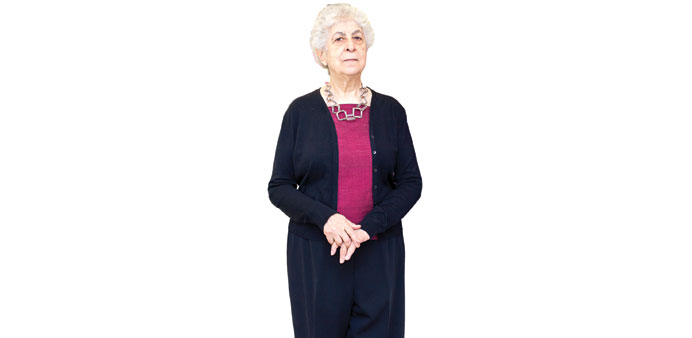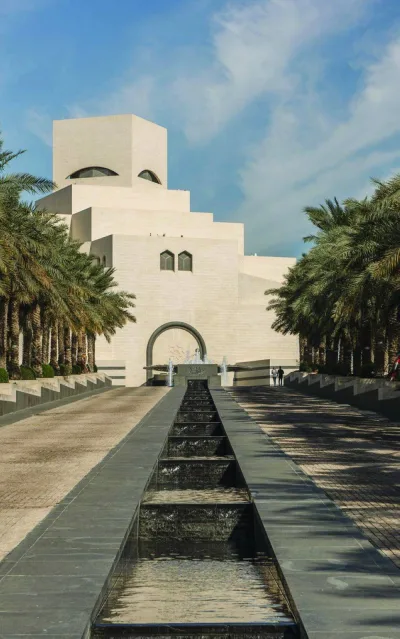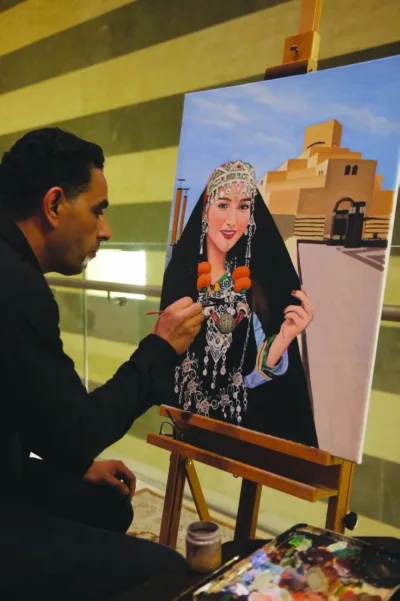She is widely credited with
inspiring the new school of
abstraction in contemporary
Arab art. Denise Marray
reports from London
A young artist is searching for a way to express herself; she is looking at a Petrus Christus painting, ‘The Virgin and Child in a Gothic Interior’. Her eye is drawn to a detail — a solitary piece of fruit — an orange depicted with exquisite care that sits bathed in light on a windowsill.
It proves to be a moment of revelation, opening up a new pathway of artistic expression. That moment in the Nelson-Atkins Museum in Kansas City, US, was described by the artist Samia Halaby during an interview with Community in the Ayyam Gallery, London, where an exhibition of her latest work is currently on view.
Halaby, who was born in Jerusalem, Palestine, is widely credited with inspiring the new school of abstraction in contemporary Arab art. Parallel to her artistic career, she is an active political campaigner for Palestine, as well as a scholar who has been instrumental in the documentation of Palestinian art, publishing her landmark text Liberation Art of Palestine: Palestinian Painting and Sculpture in the Second Half of the 20th Century, in 2002.
Reflecting on over fifty years of work as an artist, activist and teacher, she said that she can now see that her periods of loneliness, isolation, and even rejection, have been important to her development. Her family was forced into exile from Palestine during the 1948 war; at the age of eleven years she had her first taste of rejection as she tried to find her feet in her new home in Beirut, Lebanon. Then, in 1951 came another upheaval when her family moved to the United States.
She recalled how soon after arriving in Ohio, a local newspaper reporter visited the family home in Cincinnati. Halaby’s mother couldn’t face the ordeal of an interview and proposed her fourteen-year-old daughter for the task.
When Halaby saw the published article, she was amazed to read a clichéd ramble about ‘a family from the Holy Land’ and their ‘olive skinned’ daughter.
“I thought, ‘What on earth are they writing about?’. I had never in my life had a focus on skin colour,” she recalled. She added: “They tried to put me in a box and, of course, you respond by putting them into their box.”
She said that she has also experienced rejection in New York. “As an artist in New York I have not been accepted because I am Palestinian and it’s a generally Zionist atmosphere,” she said. “But the museums in the USA have been much more accepting,” she added.
Halaby is extremely dismissive of attempts, particularly by the media, to pigeon-hole people; she is equally unimpressed by the obsession with ‘identity’ and ‘roots’. She explained: “In the American media you are supposed to ‘examine your roots’. My first reaction was laughter — I am not a tree!”
“From the very beginning my attitude was that the whole world is available to me to know its history, whether African, Chinese or European,” she said.
She emphasised that her art is entirely influenced by politics. “I know I am not supposed to be political, but my art is totally based on political analysis,” she said.
“I see that the revolutionary art of the Soviet Union brought us abstraction; that the Paris commune brought us impressionism before that, and that’s when the idea of generalising blossomed in painting. The abstract impressionists in America were also very leftist and they are based on the Trade Unions movement. I admire the work of Diego Rivera with its revolutionary aspects. I want to expand that knowledge base that they created.”
She describes herself as an optimist and her latest works exude a feeling of joy. She explained the reasoning behind this outlook. “I sincerely feel that you can either wallow in depression about the ‘ugly’ world we live in, or believe, as I feel, that we will ‘clean it all up’. For example, I am sure there will be a Palestine again that is totally Arab where everybody is welcome to live.”
Halaby, who lives and works in New York, has taught widely at institutions including in the USA, the Cooper Union, the Yale School of Art, Indiana University, University of Michigan, Kansas City Art Institute, and the University of Hawaii. She has also taught short courses at Birzeit University, Palestine, and Darat al-Funun in Amman, Jordan. Her work is housed in numerous international museum collections, including Mathaf: Arab Museum of Modern Art, Qatar, The Guggenheim Museum, New York and Abu Dhabi, The British Museum, Institut du Monde Arabe, France, and the Jordan National Gallery of Fine Arts.
As a young girl, Halaby didn’t consider art as a career option. She was good at maths and sciences and expected to have a career based on these subjects like many of her family members. However, her favourite class at her American High School was art and she found herself in a quandary when considering what to study at college. Her mother suggested that as she had always enjoyed drawing she should study art. Halaby opted for art, but because she was determined to support herself and be financially independent, she chose to study commercial art and worked for a year as a commercial artist. She subsequently studied for two graduate degrees, including a Masters in Fine Art.
While studying art she remained open to criticism and advice from her professors, even when this entailed receiving some harsh reviews. “There were attributes in my work that were very similar to Palestinian folk painting which they cleansed out of me. But you can always go back to things. You always feel a little resentful but then you try things — I always felt that I needed to learn,” she said.
She sees a pattern of evolution in the lives of many painters, including herself, whereby a path is found, explored and then a new path is sought. “If you are a healthy painter you decide ‘enough is enough, it’s time to change’,” she observed.
For her such a moment came after her years of study and early into her teaching career.
“I stopped to think. I was telling myself ‘it’s time now to clean all of my professors out of my head’. So I went through all kinds of things for six months, and I started over again. I wanted the next step to be on my own and for it to be mine,” she explained.
“I tried everything but I couldn’t find a step on my own,” she added. Then came the day when she stood before the Petrus Christus in the Kansas museum. “I looked at the orange on the windowsill and there was something absolutely beautiful about the way it was painted. I went back to my studio and made a still life that resembled that little corner in the painting and it started me on a new path,” she recalled.
So how does she see her work today?
“It’s like a tree that finally gets fruit. The outpour is based on the period of thinking and isolation, and that is why I would advise artists to always be independent and to rely on themselves,” she concluded.



